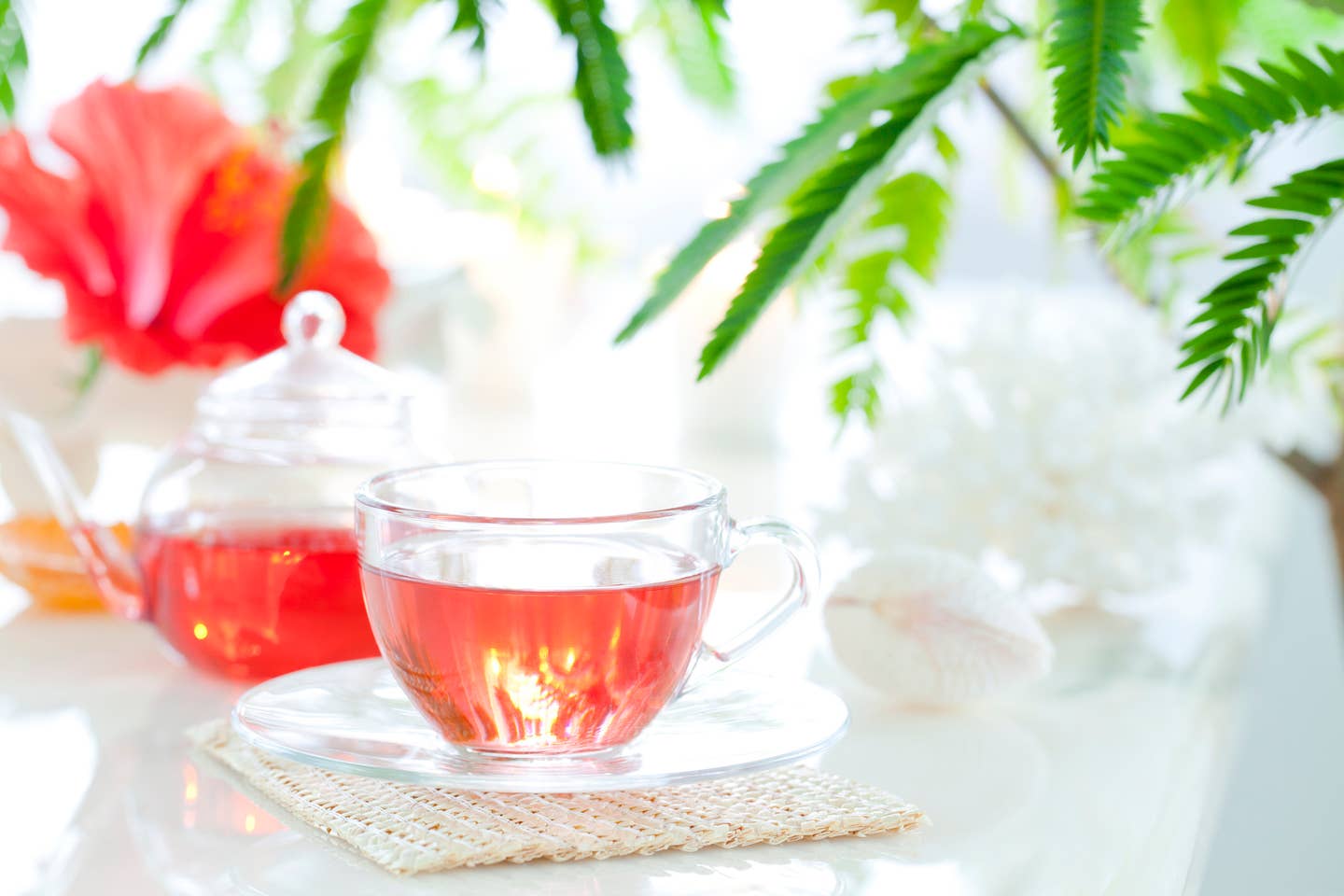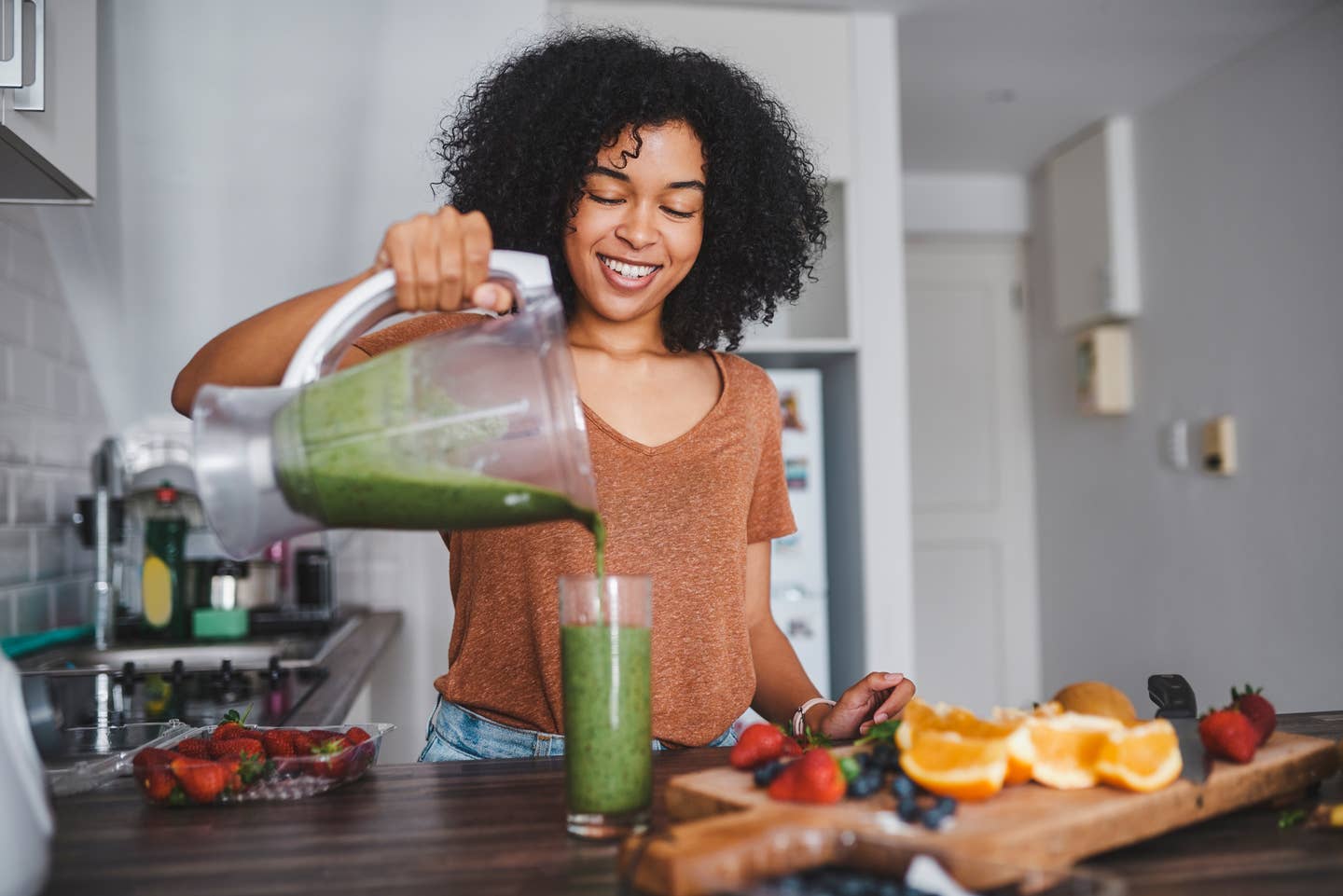
The Hidden Health Benefits of Hibiscus Flowers, According to an Expert
Hibiscus flowers aren't just a beautiful bloom to admire in warmer climates. The flower has been eaten and brewed into teas in many parts of Asia, Africa, and Central and South America for hundreds of years. The red hibiscus drink is popularly known by many names around the world. It’s called “bissap” in parts of West Africa, “sobolo” in Ghana, “sorrel” in the Caribbean, Florida cranberry in Florida, agua de Jamaica in Mexico, karkadé in Egypt, and Sudan.
There are many varieties of hibiscus, but the red flower, or roselle, has many health benefits like lowering blood pressure, stabilizing blood sugar levels and provide immunity support. There are also studies that suggest it may help boost liver health.
The Health Benefits of Hibiscus
In many parts of the world, people drink hibiscus tea and infusions as a refreshing beverage, hot or cold. I grew up having it as a cold drink, served on the streets of Alexandria, Egypt, my parents’ hometown. I was told it has a calming, relaxing effect, and I’d drink it hot before bed sometimes. It’s also known to lower blood pressure and research shows that it has a positive effect on people with hypertension. Another study found that drinking hibiscus tea every day was linked to lower overall cholesterol.
Dr. Kimberley Sommerville, MD, and Masters of Clinical Nutrition uses hibiscus, or as it’s called in Jamaica, sorrel, in her work. “Sorrel is a household plant in Jamaica, generally used as a drink during our Christmas festivities, but now being used more often all year round.”
She says that “Personally I've had sorrel since childhood and it can be incorporated into normal diets like green and chamomile tea. It tastes great and its benefits for lowering cholesterol and blood pressure are an added bonus for patients”
The flower is packed with antioxidants. Dr. Sommerville tells me that, “The Northern Caribbean University has also done studies which notes the flavonoids in sorrel as a powerful compound that can potentially be used against free radicals and cancer cells.”
The flower is also high in vitamin C and a good source of iron, both of which aid in strengthening the immune system.
While it’s most commonly used as a beverage, the flower itself is also edible and can be cooked and eaten. It’s an incredibly versatile plant and can be used as a vegan taco filler, or cooked in curries like it is in parts of India. With its tart flavor, it’s an exciting ingredient and there are many ways to incorporate it into your diet.
7 Ways to Enjoy Hibiscus
1. Hot tea
Perhaps the easiest way to use hibiscus is drinking it as a hot tea. The fresh or dried flowers can be infused with hot water and drank with any optional sweetener. It’s also common to find hibiscus tea bags sold at most grocery stores, making them even more convenient to use.
Try this for an easy at-home recipe.
2. Iced tea
Taking the easiest method of making a hot tea one step further by cooling it in the fridge for a few hours is another way to enjoy hibiscus. This ruby-colored iced tea is incredibly refreshing on a warm day, especially with some added lemon/lime or some ginger. It makes a delicious and healthy substitute for juice or sodas. Make a big batch and refrigerate for up to a week, you’ll be able to have some anytime within a week.
Try this agua de Jamaica here.
3. Cocktails
Using hibiscus in cocktails is a delicious way to get nutritional benefits while indulging in an alcoholic beverage. The cranberry-like flavor also pairs really well with different spirits, like rum, mezcal, bourbon, and gin. Its bright red color makes a beautiful-looking drink, while its tartness is easily complemented with different citrus fruits or spices. You can even boil it down to make a cordial or a syrup from it, which can easily add a touch of depth and excitement to any cocktail.
Try this recipe for a mezcal, hibiscus and cilantro cocktail.
4. Make a “mock mulled-wine”
In the colder days, making a hot hibiscus brew with winder spices can make a delicious “mulled wine” recipe without the wine. The deep red color of the hibiscus will have you fooled, while the aromatic spices like cloves and cinnamon will have your home smelling deliciously cozy. The spicy flavors of mulled wine paired with the tartness of hibiscus, make for a nutrient-packed drink that will warm you from the inside. And if you miss the alcohol, go ahead and add some wine, it will work great. Hint: a dash of bourbon would also take this drink to the next level.
Try this recipe for hibiscus “mulled wine."
5. Taco filling
In parts of Mexico, tacos de Jamaica are popular and the technique of cooking hibiscus in your tacos is a game-changer for vegans. Hibiscus flowers are chewy but tender and easily pick up any flavor that you’re cooking with. The best thing is that it’s one process that produces two products- the flower “meat” and hibiscus tea.
Chill the tea in the fridge and use the flowers to make this recipe.
6. Curry
In Kerala, India, people make a curry using hibiscus flowers called Pulinkari. The petals are stewed in a sour tamarind-based sauce, that produces a deep red, healthy and flavorful dish. Finding out that you can stew hibiscus flowers and use them in curries opens up a world of possibilities for cooking with hibiscus.
Try this Keralan-style hibiscus dish called Pulinkari.
7. Jam and Relish
Using the flowers or the tea, you can easily make a jelly/jam or if you prefer a more savory route, try making a relish. Making a simple version with just sugar and water will get you a sweet and tart jam. Using this as a base, you can begin to play around. Include other florals or citrus to enhance the flavor. Adding some spices and jalapenos will turn it into an exciting condiment, as a side to your curry dish or with some bread.
Because of its cranberry-like taste, it’s also a popular choice at thanksgiving to use as “cranberry sauce.”
Try this chutney recipe as a stand-in for cranberry sauce.
Or go the sweet, floral route and make this hibiscus and rose jelly.
8. Ice-cream/Sorbet
Another exciting use for hibiscus tea to transform that ruby liquid into ice cream or a refreshing sorbet. The deep red color lends itself to a beautifully rich-looking frozen dessert, with a tangy taste that even those without a sweet tooth will love.
For a creamy, vegan ice cream recipe, try this coconut and hibiscus ice cream.
For the hot days ahead, this ginger and hibiscus sorbet is sure to be a hit.
Top 10 Sources of Plant-Based Protein According to a Nutritionist
1. Seitan
Protein: 21 grams in ⅓ cup (1 ounce) Seitan isn’t as popular as other proteins, but it should be! Made from wheat gluten, its texture resembles ground meat. It’s often used in pre-made veggie burgers or meatless nuggets. Seitan has a savory taste, like mushrooms or chicken, so it works well in dishes that call for an umami flavor. With a hearty texture, seitan can be the star of practically any vegan main dish. Add it to stir-fries, sandwiches, burritos, burgers, or stews. Like tofu, seitan will take on the flavor of any marinade or sauce.
2. Tempeh
Protein: 16 grams in 3 ounces If you like a protein with a bit of bite, add tempeh to your list. Made from fermented soybeans, tempeh has a slightly nutty flavor and is pressed into a block. Most varieties include some sort of grains, such as barley or millet. Not only is tempeh a plant-based source of protein, but the fermentation process also creates good-for-your-gut probiotics. You can cut tempeh right off the block and use it as the base for a sandwich or pan-fry it with some sauce. Or, crumble, heat, and make it the star of your next taco night.
3. Lentils
Protein: 13 grams in ½ cup cooked Lentils come in multiple varieties--red, yellow, green, brown, black. Regardless of the type lentils are small but mighty nutritional powerhouses. They pack a good amount of protein as well as iron, folate, and fiber. When cooked, brown lentils retain their texture and can be the base for a grain bowl or make a hearty substitute for ground meat in meatballs, lasagna, tacos or Bolognese. Red lentils are a bit softer and make a nice add-in for a hearty soup, chili, or stew.
4. Hemp Seeds
Protein: 10 grams in 3 tablespoons Hemp seeds are a tender and nutty seed, derived from the hemp plant. They contain good amounts of omega-3s, iron, folate, magnesium, phosphorus, and manganese. They are also a solid source of both soluble and insoluble fiber, which helps to keep your digestive tract healthy and humming. Because they pack a double whammy of protein and healthy fats, hemp seeds can help satisfy hunger, preventing those embarrassing stomach growls as you slog your way to your lunch break. Add them to your morning smoothie or sprinkle them on top of yogurt, oatmeal, or even a salad.
5. Tofu
Protein: 9 grams in 3 ounces (⅕ of a block) Made from coagulated soybeans, tofu is the most popular plant-based protein. Soy is one of the only meatless "complete" proteins, meaning that it contains all of the essential amino acids that the body can’t make but needs for muscle and immune function. With 15% of your daily calcium needs, tofu is also a good replacement for dairy.
6. Edamame
Protein: 9 grams of protein in ½ cup This sushi appetizer is a nutrient powerhouse, so eat it anytime. Edamame is really just another name for soybeans in their pods. Let’s list off some stats--a small ½-cup serving of edamame has 9 grams of protein, 15% of your daily vitamin C, 10% of your daily iron and 16% of your daily fiber. Keep a bag of edamame in your freezer to serve as a fun-to-eat side dish or opt for the shelled variety to toss into salads or a grain bowl.
7. Quinoa
Protein: 8 grams per cup (cooked) Quinoa is an ancient grain and since it's gluten-free a great choice for anyone avoiding gluten. Add it to your burger recipe to create filling texture, or instead of meat in your taco or burrito. Quinoa is among the healthiest foods on the planet, delivering phytonutrients that have anti-inflammatory qualities, so keep it in your pantry for any meal that needs a filling grain. Just remember to soak it and rinse before cooking to get rid of any bitter taste.
8. Black Beans
Protein: 7 grams in ½ cup (canned) Eating beans on the regular might as well be a prerequisite for a plant-based diet. Not only are canned black beans inexpensive, but they also contribute 10% of your daily iron and 25% of your daily fiber to your diet. For less than $1 a can, beans can be the star of tacos, quesadillas, salads, soups, burgers, or dips.
9. Amaranth
Protein: 6 grams in ⅔ cup (cooked) Chances are you’ve never cooked amaranth. But you should, since this tiny, gluten- free grain is packed with almost 30% of your daily fiber and 20% of your daily iron. Cook it like a traditional grain to yield a soft, porridge-like texture. Many people add amaranth to other a hot breakfast cereal mixture, like oats and quinoa. It also pops like popcorn. Toss it in a pot with some oil and wait for it to pop up into a nutritious snack.
10. Peas
Protein: 5 grams in ⅔ cup If peas were one of your most hated veggies as a kid, it’s time to give them another chance. These green beans are a great low-calorie protein to keep in your freezer. Sure, they don’t always taste great when steamed or microwaved (who wants to eat mushy, overcooked peas?), but they do blend well into a yummy puree that can be slathered on toast. To amp up the flavor, add some lemon juice or mint to your mix before you blend.
More From The Beet






